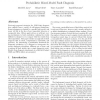Free Online Productivity Tools
i2Speak
i2Symbol
i2OCR
iTex2Img
iWeb2Print
iWeb2Shot
i2Type
iPdf2Split
iPdf2Merge
i2Bopomofo
i2Arabic
i2Style
i2Image
i2PDF
iLatex2Rtf
Sci2ools
ITC
1998
IEEE
1998
IEEE
Probabilistic mixed-model fault diagnosis
Previously-proposed strategies for VLSI fault diagnosis have su ered from a variety of self-imposed limitations. Some techniques are limited to a speci c fault model, and many will fail in the face of any unmodeled behavior or unexpected data. Others apply ad-hoc or arbitrary scoring mechanisms to fault candidates, making the results di cult to interpret or to compare with the results from other algorithms. This paper outlines an approach to fault diagnosis that is robust, comprehensive, extendable, and practical. By introducing a probabilistic framework for diagnostic prediction, it is designed to incorporate disparate diagnostic algorithms, di erent sets of data, and a mixture of fault models into a single diagnostic result. Results from diagnosis experiments on a Hewlett-Packard ASIC and FIB'd defects are presented.
| Added | 05 Aug 2010 |
| Updated | 05 Aug 2010 |
| Type | Conference |
| Year | 1998 |
| Where | ITC |
| Authors | David B. Lavo, Brian Chess, Tracy Larrabee, Ismed Hartanto |
Comments (0)

